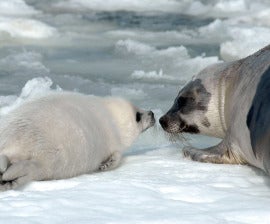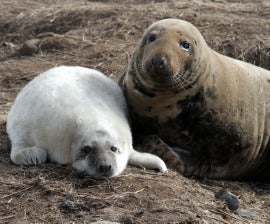-

We must save them. HSI
-

Looking back. HSI
-

Grey seal mother and pup. HSI
-

Thin ice means mass pup mortality. HSI
-

On the hunt. HSI
-

Senseless cruelty. HSI
-

Dragged back to the boat. HSI
With hundreds of thousands of seals clubbed and shot to death for their fur in most years, Canada’s commercial seal hunt is the largest slaughter of marine mammals on Earth. It is also the most brutal.
It’s a cruel slaughter of baby seals
Canadian government statistics confirm more than 97 percent of the seals killed in the past five years have been babies less than three months of age, and the majority has been just one month old or less. At the time of slaughter, many of these pups have not yet eaten their first solid meal or taken their first swim, leaving them utterly defenseless against the sealers. The baby seals are killed for their fur and their carcasses are routinely left to rot on the ice. HSI video evidence shows wounded baby seals left to suffer in agony, conscious seals pup sliced open or impaled on metal hooks and dragged across the ice, and seals killed with illegal weapons. Our footage has prompted governments around the world to take action to ban their trades in seal products, and Canadian veterinary experts to call the seal hunt “inherently inhumane” [PDF].
It threatens seal populations
Independent scientists have condemned the current Canadian seal hunt management plan as reckless and irresponsible, stating that it poses a threat to the survival of seal populations. Notably, today’s seal kill levels meet and exceed those of a half century ago, when sealers quickly reduced the harp seal population by as much as two thirds. Harp seals now face an added threat to their existence, as climate change causes their sea ice habitat to diminish at an alarming rate. In recent years, the Canadian government has estimated up to 100 percent mortality for seal pups born in key whelping areas, when the sea ice melted before they were old enough to survive in open water.
Most Canadians oppose it
Polling consistently shows the overwhelming majority of Canadians oppose the seal slaughter and their tax dollars being used to promote it. Notably, even in Newfoundland, where the vast majority of sealers live, 80 percent of residents believe that the seal pups that comprise virtually all of the seal slaughter should be protected, while an additional five percent believe seals should not be killed at any age.
It costs more than it brings in
Sealers are commercial fishermen who earn, on average, less than five percent of their incomes from killing seals. In recent years, the landed value of the seal hunt has been in the region of $1 million, less than one tenth of one percent of the GDP of Newfoundland. Despite its low economic returns, the Canadian government continues to invest massive subsidies in the commercial sealing industry each year. In 2001, the Canadian Institute for Business and the Environment produced a report detailing more than $20 million in government subsidies provided to the sealing industry over the previous seven years. Presently, it is estimated that Canada spends more than $4.3 million annually in Coast Guard support for the slaughter alone.
In 2005, following decades of failed negotiations with the Canadian government, The Humane Society of the United States and a network of the world’s most powerful animal protection groups launched a global boycott of Canadian seafood products until the seal slaughter is ended for good. Since the boycott began, thousands of businesses and hundreds of thousands of individuals have pledged to avoid some or all Canadian seafood until the seal hunt has ended. Canada is now attempting to negotiate a free trade deal with the European Union reportedly worth $12 billion to Canada’s economy annually, including $36 million for the Canadian fishing industry. At the same time, Canada has launched an aggressive attack on European values and democratic processes, launching a WTO challenge in response to the EU ban on seal product trade. Government reports suggest that the seal issue could negatively impact ratification of the deal by the European Parliament.
It could easily be ended
HSI Canada believes the Canadian government should end the commercial seal slaughter by implementing a one-time buyout of the commercial sealing industry. This cost-effective solution would compensate fishermen for any lost revenue as the seal hunt is closed, and it would provide a graceful way for Canada to move beyond commercial sealing. Notably, a 2010 poll by Ipsos Reid found that half of Newfoundland sealers holding an opinion already support this plan.
To learn more, please visit our Seal Slaughter Q&A and Protect Seals Resources pages.
